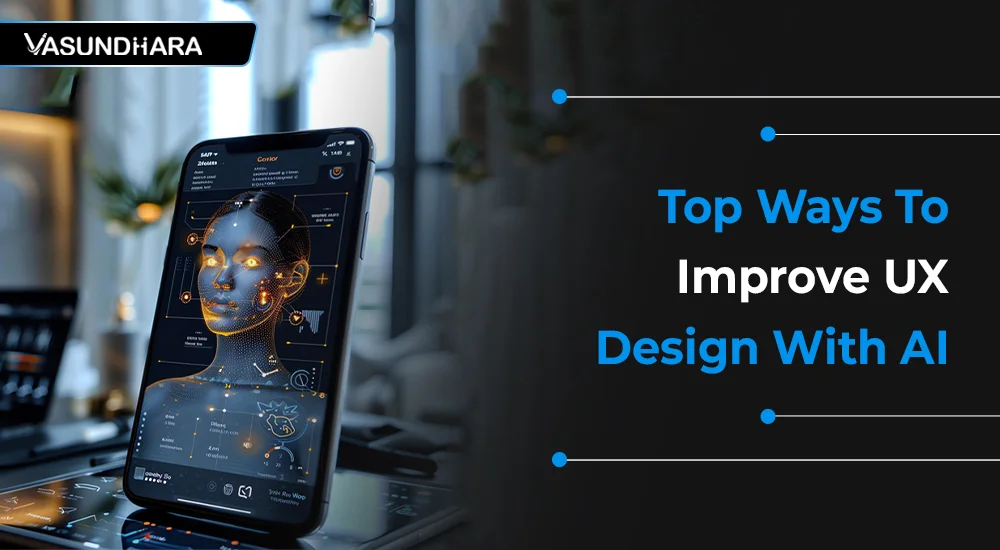Top Ways To Improve UX Design With AI


- Aug 14, 2024
User Experience (UX) design has become a pivotal factor in the success of digital products and services. With the rapid advancements in technology, artificial intelligence (AI) has emerged as a transformative force in the realm of UX design. AI's integration into UX design processes is not just a trend but a significant evolution that enhances the way users interact with digital interfaces.
This blog explores how has AI been affecting UX design, its current features, practical ways to improve UX design with AI, and what the future holds for this evolving field.
AI is revolutionizing modern UX design by enhancing personalization, automating tasks, and improving user interactions. AI algorithms analyze user data to tailor experiences, offering personalized content, recommendations, and interfaces that align with individual preferences. This personalization boosts user engagement and satisfaction. Additionally, AI automates repetitive tasks like A/B testing and layout generation, streamlining the design process and ensuring consistency.
AI-driven tools also enable more sophisticated user interactions through natural language processing and chatbots, providing real-time support and enhancing overall usability. By leveraging AI, designers can create more intuitive, efficient, and user-centered experiences, ultimately leading to more successful digital products.
Also read: What is Generative AI? Everything You Need to Know
AI’s impact on UX design is profound, affecting various aspects of how designs are created, tested, and refined. Here’s a closer look at how AI is reshaping UX design:
AI tools analyze user interactions and feedback to provide designers with actionable insights. This data-driven approach allows for more precise and targeted design decisions, improving the overall effectiveness of user interfaces.
AI-powered design tools automate tasks such as layout generation, color palette selection, and responsiveness testing. This streamlining reduces the time and effort required for these tasks, allowing designers to focus on more strategic and creative aspects of the design process.
AI algorithms enable designers to create highly personalized user experiences by analyzing user data and tailoring content, recommendations, and interfaces to individual preferences. This personalization fosters greater user engagement and satisfaction.
AI technologies such as voice recognition and computer vision enhance accessibility for users with disabilities. These technologies provide alternative ways for users to interact with digital interfaces, ensuring a more inclusive user experience.
AI’s predictive capabilities allow designers to anticipate user needs and behaviors, leading to more proactive design solutions. By addressing potential issues before they arise, designers can create more seamless and user-friendly experiences.
Also read: The Role of AI and ML in DevOps Transformation
Integrating AI into UX design introduces several advanced features that enhance user experiences and streamline the design process. Here are some notable features of AI UX design:
AI can create adaptive interfaces that adjust in real-time based on user behavior and preferences. For example, an AI-driven interface might change its layout or content based on the user’s past interactions, providing a more personalized experience.
AI algorithms analyze user data to offer relevant recommendations, such as product suggestions or content feeds. These smart recommendations improve user engagement by presenting users with content that aligns with their interests and preferences.
AI-driven chatbots provide real-time support and assistance, handling common queries and guiding users through various processes. Chatbots enhance user interactions by offering quick and efficient responses to user inquiries.
AI tools automate A/B testing processes, analyzing results more quickly and accurately than traditional methods. This automation helps designers identify the most effective design variations and optimize user experiences.
AI’s predictive capabilities allow designers to anticipate user needs and preferences, leading to proactive design solutions that address potential issues before they arise. This predictive approach enhances the overall user experience by reducing friction and improving usability.
To effectively leverage AI for UX design improvements, designers should consider the following strategies:
AI-powered analytics tools can dramatically enhance UX design by providing deep insights into user behavior, preferences, and pain points. These tools analyze vast amounts of data from user interactions, such as clicks, navigation patterns, and session durations. By leveraging machine learning algorithms, they identify trends and patterns that might not be immediately obvious.
This data-driven approach helps designers make informed decisions about layout changes, content adjustments, and feature enhancements. For example, AI can highlight which parts of a website or app users frequently visit or avoid, guiding designers to optimize those areas for better engagement.
Also read: How To Build An AI Software: A Comprehensive Guide
Personalization engines use AI to tailor content, recommendations, and interfaces to individual users based on their behavior and preferences. These engines analyze user data, such as past interactions, purchase history, and browsing habits, to offer customized experiences. For instance, an AI-driven recommendation system on an e-commerce site might suggest products based on a user’s previous searches and purchases, leading to higher conversion rates and customer satisfaction.
By implementing personalization engines, designers can create more relevant and engaging experiences, making users feel valued and understood.
AI chatbots provide real-time support and assistance, enhancing user interactions and streamlining customer service. These chatbots use natural language processing (NLP) to understand and respond to user queries in a conversational manner. They can handle a wide range of tasks, from answering frequently asked questions to guiding users through complex processes.
For example, a chatbot on a travel booking site might help users find flights, compare prices, and complete bookings without needing human intervention. By deploying AI chatbots, designers can improve user satisfaction, reduce response times, and free up human resources for more complex issues.
AI tools can automate various design tasks, significantly speeding up the design process and ensuring consistency across different platforms. For example, AI-driven design tools can generate layout variations, suggest color palettes, and create responsive designs based on predefined criteria.
Automation also extends to tasks like creating design prototypes and conducting usability tests. By automating these repetitive and time-consuming tasks, designers can focus on more strategic and creative aspects of their work, leading to more efficient and effective design processes.
AI technologies, such as voice recognition and computer vision, are crucial in improving accessibility for users with disabilities. Voice recognition allows users to interact with digital interfaces through spoken commands, making it easier for individuals with limited mobility or visual impairments to navigate websites and apps.
Computer vision technologies can analyze and describe visual content, assisting users with visual impairments. Additionally, AI can automatically generate captions and transcripts for multimedia content, making it more accessible to users with hearing impairments. Designers can create more inclusive and user-friendly user experiences by leveraging these AI technologies.
AI tools continuously monitor user interactions and feedback, providing real-time data that can be used to optimize designs. These tools track various metrics, such as user engagement, conversion rates, and error reports, and analyze this data to identify areas for improvement.
For example, if an AI tool detects that users frequently abandon a checkout process at a specific point, designers can investigate and address the issue to improve the overall user experience. By regularly monitoring and optimizing designs based on AI-driven insights, designers can ensure that their products remain effective and aligned with user needs.
Also read: How AI is Transforming E-commerce Website Development
The future of AI in UX design promises advanced personalization, predictive capabilities, and more intuitive interactions. AI will enable deeper customization, tailoring experiences in real-time based on user data. Enhanced predictive analytics will allow designers to anticipate user needs and proactively address potential issues. Natural language processing and computer vision advancements will lead to more natural and seamless user interactions, including voice and gesture controls.
Integration with the Internet of Things (IoT) will create interconnected user experiences across multiple devices. Ethical considerations, such as data privacy and bias, will also play a crucial role in shaping the responsible use of AI in UX design. These developments will lead to more engaging, intuitive, and inclusive digital experiences.
The question of whether AI will replace UX designers is a common concern. While AI is transforming the design process and automating certain tasks, it is unlikely to replace human designers entirely. AI can handle repetitive and data-driven tasks, but it lacks the creativity, empathy, and contextual understanding that human designers bring to the table.
AI is a tool that complements and enhances the work of UX designers, rather than replacing them. Designers will continue to play a crucial role in shaping user experiences, interpreting data, and making creative decisions. The collaboration between AI and human designers will lead to more innovative and effective UX solutions.
Also read: How To Integrate AI Into An App
AI is revolutionizing UX design by providing new tools and techniques that enhance user experiences and streamline design processes. From advanced personalization and automation to predictive analytics and improved accessibility, AI offers numerous ways to improve UX design. AI's role in UX design will only grow as technology advances, bringing new opportunities and challenges.
Designers should embrace AI as a valuable tool that augments their skills and capabilities. By leveraging AI effectively, designers can create more engaging, personalized, and accessible user experiences that meet their users' evolving needs.
Our experts at Vasundhara Infotech specialize in all aspects of the latest technologies. If you require any services for AI development or other purposes, please contact us. We have a team of professionals ready to assist your business expand massively in every manner.
Copyright © 2026 Vasundhara Infotech. All Rights Reserved.
